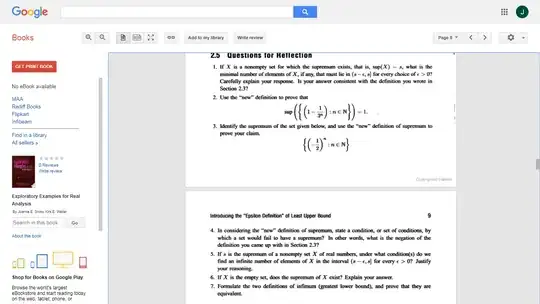Need help in vetting my answers for questions in sec 2.5 in chap. 2 (page 8) in CRM series book by MAA: Exploratory Examples for Real Analysis, By Joanne E. Snow, Kirk E. Weller.  The question refers also to "new definition" introduced in Q. 2.3 (in answer for part $4$) in my last post, that am repeating below for ease of reference:
The question refers also to "new definition" introduced in Q. 2.3 (in answer for part $4$) in my last post, that am repeating below for ease of reference:
Let there be a nonempty set $X$ with supremum $s$, then $X\cap(s - \epsilon, s]\ne \emptyset, \,\, \forall \epsilon\gt 0$.
Q. 2.5:
- If $X$ is a nonempty set for which the supremum exists, that is, $sup(X)=s$, what is the minimal number of elements of $X$, if any, that must lie in $(s-\epsilon, s]$ for every choice of $\epsilon\gt 0$. Carefully, explain your response. Is your response consistent with the definition you wrote in Section 2.3?
Not sure what the question is asking as for reals cannot count elements in any interval. However, my answer is : Minimal number of elements of $X$ in the interval $(s-\epsilon, s]$ is $= (s-\epsilon, s]$, if $s\in X$, else $(s-\epsilon, s)$ if $s\notin X$.
- Use the "new" definition to prove that
$$\sup(\{(1- \frac1{3^n})\,\,: n \in N \})= 1.$$
$s=1$, for $n\rightarrow \infty$. Below is table for set members for few values of $n$: $$\begin{array}{c|c|} & \text{$n\in \mathbb{N}$}& \text{$(1- \frac1{3^n})$}\\ \hline a & 1& \frac23=0.\overline{6}\\ \hline b & 2& \frac89=0.\overline{8}\\ \hline c & 3& \frac{26}{27}=0.\overline{962}\\ \hline d & 4& \frac{80}{81}=0.\overline{987654320}\\ \hline \vdots\\ \hline \infty & n\rightarrow \infty& \approx 1\\ \hline \end{array}$$ $s\not\in \{(1- \frac1{3^n}\,\,: n \in N \})$, as $s$ does not lie in the set.
$(1- \frac1{3^n}) \in [\frac23, 1)$.
$\epsilon \in\mathbb{R}, \epsilon\gt 0\implies \forall \epsilon \gt 0: n\lt \infty$, as $s - \epsilon \lt 1$.
For interval $(s-\epsilon,s]$, the lower bound implies for $\epsilon\gt 0$ that $ s-\epsilon \lt 1\implies n \lt \infty$, & the upper bound implies the max. value is $s=1$ at $n= \infty$. All possible values of $n$ are covered in the interval $(s-\epsilon,s]$ with $n=\infty$ at the upper bound.
- Identify the supremum of the set given below, & use the "new" definition of supremum to prove your claim: $$\{(-\frac12)^n\,\,: n \in N \}$$
$$\sup(\{(-\frac12)^n\,\,: n \in N \})= 1.$$
$s=\frac14$, for $n=2$. Below is table for set members for few values of $n$: $$\begin{array}{c|c|} & \text{$n\in \mathbb{N}$}& \text{$(-\frac12)^n$}\\ \hline a & 1& -\frac12=-0.5\\ \hline b & 2& \frac14=0.25\\ \hline c & 3& -\frac 18=-0.125\\ \hline d & 4& \frac{1}{16}=0.0625\\ \hline \vdots\\ \hline \infty & n\rightarrow \infty& \approx 0\\ \hline \end{array}$$
As $-(\frac12)^n\in \{-\frac12, \cdots, \frac14\}$, & as $n \rightarrow \infty, -(\frac12)^n \approx 0$.
For interval $(s-\epsilon,s]$, the lower bound implies for $\epsilon\gt 0$ that $ s-\epsilon \lt \frac14$, & the upper bound implies the max. value is $s=\frac14$. All possible values of $n$ are covered in the interval $(s-\epsilon,s]$ with $n=2$ at the upper bound.
- In considering the "new" definition of supremum, state a condition, or set of conditions, by which a set would fail to have a supremum? In other words, what is the negation of the definition that you came up with in Section 2.3?
The "new" definition is based on premises: a nonempty set $X$, a positive real number $\epsilon$, & the half-open interval $(s−\epsilon,s]$, where $s$ denotes the supremum.
Out of this only the first premise can be negated, as then the two further assumptions of : (i) positive real non-negative $\epsilon$ does not hold, (ii) similarly, the assumption of having interval of values: $(s-\epsilon, s]$ cannot hold.
Hence, the negation of "new" definition is:
"new definition": Let there be a nonempty set $X$ with supremum $s$, then $X\cap(s - \epsilon, s]\ne \emptyset, \,\, \forall \epsilon\gt 0$.
"negation": $\forall X =\emptyset$, supremum $=-\infty$, & there is no possible $\epsilon\gt 0$.
- If $s$ is the supremum of a nonempty set $X$ of real numbers, under what condition(s) do we find an infinite number of elements of $X$ in the interval $(s-\epsilon, s]$ for every choice of $\epsilon\gt 0$. Justify your reasoning.
The members of set $X$ lie in reals, so for infinite number of elements $\forall \epsilon \gt 0$, need $s = \infty$. Then the interval $(s - \epsilon, s]$ for any positive value of $\epsilon$ is having infinite number of values.
- If $X$ is the empty set, does the supremum of $X$ exist? Explain your answer.
supremum $\ge$ larger than any value in the set, & is the $lub$. For an empty set, any value can act as upper bound, & supremum is the least of any possible value. so $s=-\infty$.